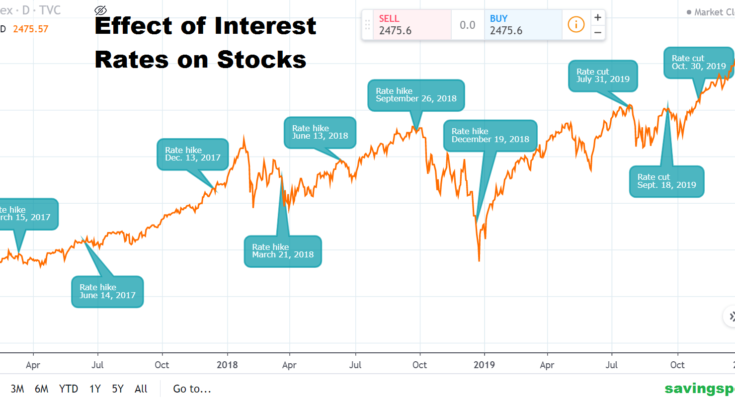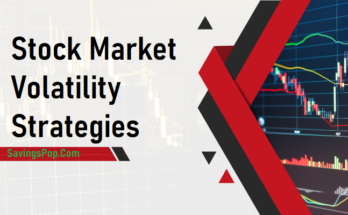Interest rates play an important function within the financial markets. They influence everything from purchaser spending to company investment, notably, the inventory market. Understanding the relationship between interest prices and stocks can assist traders make better selections. This article explores this complex relationship in detail, discussing the effect of interest rates on stocks, the mechanisms of effect, sector-precise results, global perspectives, and investor techniques.
Understanding Interest Rates
Definition and Types of Interest Rates
Interest rates are the cost of borrowing cash and then going back on savings. They are usually expressed as a percentage of the foremost amount. There are numerous types of hobby rates:
- Nominal Interest Rate: This is the said hobby rate on a mortgage or funding with no modifications for inflation. It is the most effective shape of interest fee and is often visible in loan agreements and financial savings debts.
- Real Interest Rate: This charge adjusts the nominal price to account for inflation, offering a greater accurate degree of the fee of borrowing or the real yield on an investment. It is calculated because the nominal hobby fee minus the inflation charge.
- Effective Interest Rate: This rate takes compounding into account and represents the actual price of borrowing or the real yield on an investment over a period. It affords a more correct measure than the nominal price when the hobby is compounded more than once every 12 months.
Factors Influencing Interest Rates
Several factors influence the level of interest rates, including:
- Economic Indicators: Key indicators inclusive of inflation, unemployment, and GDP increase notably affect interest prices. For example, high inflation often ends in higher hobby prices as central banks attempt to quiet down the economic system.
- Central Bank Policies: Central banks, like the Federal Reserve in the United States, play an important function in placing interest prices. They use financial coverage gear to steer costs based on monetary situations. For instance, the Fed may decrease prices to stimulate the economy through a recession or raise prices to reduce inflation.
- Global Economic Conditions: Economic occasions in different nations can affect domestic interest fees. For example, a monetary disaster in a chief economic system can cause modifications in international capital flows, affecting hobby rates internationally.
The Stock Market: An Overview
Definition and Function of the Stock Market
The stock market is a marketplace for buying and selling shares of publicly traded corporations. It serves several important functions:
- Capital Raising: Companies use the stock marketplace to raise capital by issuing stocks to buyers. This capital may be used for expansion, research and development, and other business activities.
- Wealth Generation: The stock market affords opportunities for investors to grow their wealth through shopping for and preserving stocks of companies that appreciate over time.
- Price Discovery: The inventory marketplace allows for determining the fee of a corporation’s shares primarily based on delivery and call for dynamics.
- Liquidity: The stock market gives liquidity, permitting buyers to purchase and promote shares.
Key Players in the Stock Market
The stock market comprises various participants, each playing a specific role:
- Individual Investors: These are private those who buy and sell stocks for non-public portfolios. They can range from small retail buyers to high-net-really-worth individuals.
- Institutional Investors: These consist of entities together with a mutual price range, pension budget, coverage corporations, and hedge funds. They frequently manipulate huge sums of cash and might have a widespread effect on inventory expenses due to the size of their trades.
- Market Makers and Brokers: Market makers facilitate buying and selling through shopping for and selling stocks to offer liquidity. Brokers act as intermediaries between shoppers and dealers, executing trades on behalf of investors.
Relationship Between Interest Rates and Stock Prices
Theoretical Perspectives
The relationship between interest rates and stock prices can be explained through several theoretical models:
- Discounted Cash Flow (DCF) Model: This model values an agency based totally on the present price of its anticipated destiny cash flows. Higher interest rates increase the bargain fee, lowering the existing cost of destiny coins flows and for that reason reducing inventory fees.
- Cost of Capital: Interest rates influence the value of capital for companies. Higher prices boom borrowing expenses, reducing profitability and funding elegance, and main to lower stock fees.
- Opportunity Cost: When interest rates rise, the opportunity cost of conserving shares will increase. Investors may additionally shift their funds to constant-income securities like bonds, which come to be greater attractive relative to stocks.
Historical Evidence
Historical data provides valuable insights into how interest rates affect stock prices:
- 2008 Financial Crisis: During the 2008 financial crisis, central banks worldwide slashed interest rates to near-zero levels to stimulate the economy. This led to a significant rebound in stock markets as cheap borrowing costs spurred investment.
- Dot-com Bubble: In the late 1990s, the Federal Reserve raised interest rates to curb the overheating economy and stock market. The subsequent tightening of monetary policy contributed to the bursting of the dot-com bubble in 2000.
Effect of Interest Rates on Stocks
Effect of interest rates on stocks are discussed below:
Cost of Borrowing
Interest rates directly affect the cost of borrowing for companies:
- Corporate Borrowing: Higher interest rates increase the cost of debt, reducing corporate profits. This can lead to lower stock valuations as investors anticipate lower future earnings.
- Investment Decisions: When borrowing costs are high, companies may delay or scale back investment projects, impacting their growth prospects and stock prices.
Consumer Spending and Business Investment
Interest rates influence consumer behavior and business investment:
- Consumer Spending: Higher interest rates make loans more expensive, reducing consumer spending on big-ticket items like houses and cars. This can lead to lower revenues for companies, affecting their stock prices.
- Business Investment: Companies may reduce capital expenditures and expansion plans in response to higher borrowing costs, impacting their growth and profitability.
Investor Behavior and Sentiment
Interest rate changes can significantly influence investor behavior and sentiment:
- Risk Appetite: Higher interest rates can reduce investors’ risk appetite. As bonds and other fixed-income securities become more attractive, investors might shift their portfolios away from stocks.
- Market Sentiment: Expectations of rising interest rates can create uncertainty and negatively affect market sentiment, leading to volatility in stock prices.
Sector-Specific Impacts
Interest-Sensitive Sectors
Certain sectors are more sensitive to interest rate changes:
- Financials: Banks and other economic establishments gain from higher interest quotes as they are able to fee greater for loans relative to their value of budget, increasing net hobby margins and profitability.
- Real Estate: Higher interest rates can cause higher mortgage rates, lowering demand for property and impacting real estate corporations’ revenues and inventory expenses.
Less Affected Sectors
Some sectors are less impacted by interest rate changes:
- Consumer Staples: Products like food and family gadgets are requirements, with a call for final noticeably stable irrespective of interest rate fluctuations.
- Healthcare: The call for healthcare offerings is generally inelastic, making this sector less sensitive to interest rate adjustments.
Global Perspectives
International Interest Rate Policies
Interest rate policies vary across countries, impacting global stock markets:
- United States: The Federal Reserve’s interest rate decisions significantly influence global financial markets. Changes in U.S. rates can lead to capital flows across borders, affecting stock prices worldwide.
- Europe: The European Central Bank (ECB) also plays a crucial role in setting interest rates for the Eurozone. Its policies can impact European and global stock markets.
- Japan: The Bank of Japan’s (BoJ) policies, including negative interest rates, influence both domestic and international markets.
Emerging Markets
Interest rate changes in developed economies can have a significant impact on emerging markets:
- Capital Flows: Higher interest rates in developed countries can lead to capital outflows from emerging markets as investors seek higher returns, causing stock market volatility.
- Currency Impact: Changes in interest rates can also affect exchange rates, impacting emerging markets’ exports and stock markets.
Strategies for Investors
Adjusting Investment Portfolios
Investors can adjust their portfolios in response to interest rate changes:
- Diversification: Diversifying across asset training can assist mitigate risks related to interest charge adjustments. Including bonds, real estate, and other assets can provide balance.
- Defensive Stocks: Investing in protective shares, inclusive of those in customer staples and healthcare sectors, can shield during intervals of growing hobby rates.
Hedging Against Interest Rate Risks
Several strategies can help investors hedge against interest rate risks:
- Options and Futures: Using monetary instruments like options and futures can shield in opposition to unfavorable hobby price actions.
- Interest Rate Swaps: These agreements allow traders to alternate destiny hobby price bills, helping stabilize income and manipulate hobby price publicity.
Conclusion
Understanding the effect of interest rates on stocks is important for making informed investment choices. By thinking about ancient trends, theoretical models, and quarter-particular effects, investors can better navigate the complexities of the stock marketplace. Monitoring global economic situations and principal bank rules can also provide treasured insights. By using strategic adjustments and hedging techniques, buyers can manipulate dangers and capitalize on possibilities in unique interest price environments.
Interest fees and inventory prices are intricately related via numerous mechanisms, together with the fee of borrowing, patron spending, and investor behavior. While better quotes commonly lead to lower inventory prices, the effect can range throughout sectors and global markets. Investors need to stay informed and adapt their techniques to control the dangers and possibilities supplied via converting interest costs.




